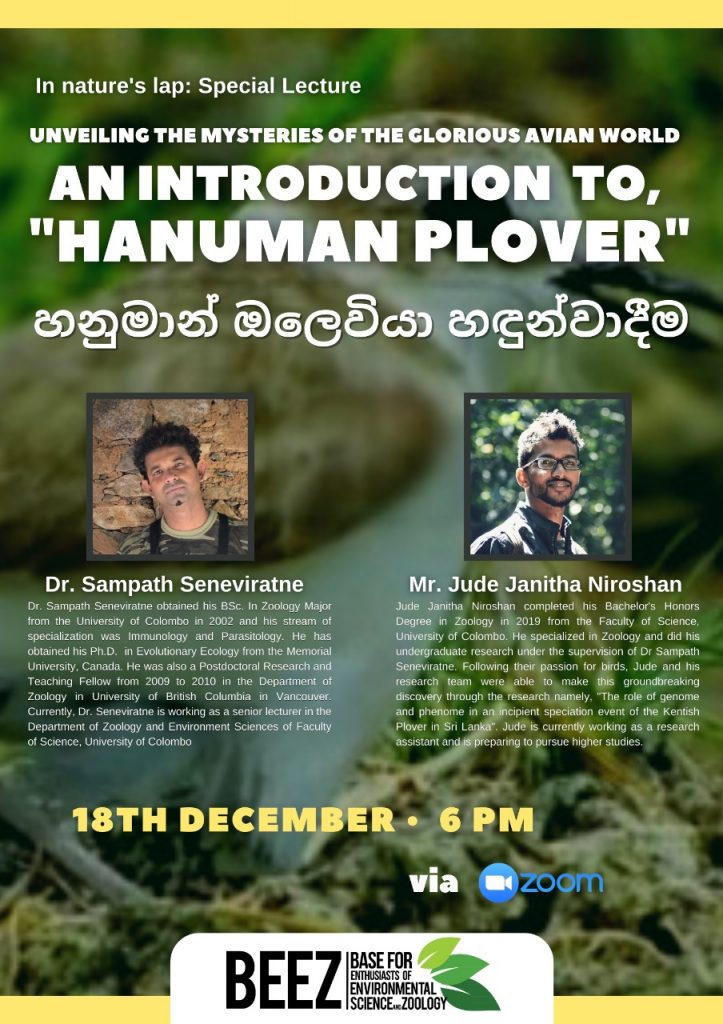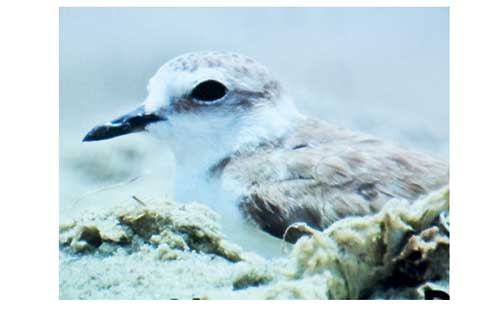
The clock ticked six in the evening on 18th December 2020 and it was not another normal day for all of us at BEEZ. We were exactly busy as bees and excited about the special webinar which was about to happen. It was not another usual zoom lecture but a special session on the most recent discovery made about the avian world by two personalities related to our university, our faculty and most importantly, our department, the Department of Zoology and Environment Sciences!
This special webinar “An Introduction to Hanuman Plover” was about the discovery of a new bird species, by Dr. Sampath Seneviratne, a senior lecturer attached to the Department of Zoology and Environment Sciences, University of Colombo and his undergraduate research student Mr. Jude Janitha. This groundbreaking discovery was a result of Mr. Jude’s 4th year undergraduate research project, “The role of genome and phenome in an incipient speciation event of the Kentish Plover in Sri Lanka”. As the official organization affiliated to the Department of Zoology and Environment Sciences, BEEZ was highly privileged to organise this session and it was a significant opportunity for all the members of BEEZ.
Once the webinar began, myself as the secretary, provided an introduction on this session explaining what it was about and welcomed the audience on behalf of the executive committee of BEEZ. We were delighted to see the presence of Prof. Deepthi Wickramasinghe, the head of the Department of Zoology and Environment Sciences, members of our academic staff, conservationists, environmentalists and a lot of our university students. The count of the participants nearly hit 130 and the crowd seemed to be very enthusiastic towards the topic discussed. It was a sign that this work was going to be legendary.
Dr. Sampath Seneviratne was introduced by Prof. Deepthi Wickramasinghe and she also congratulated Dr. Seneviratne and his team for this discovery. Prof. Deepthi Wickramasinghe further stated that the scientists are inspired by the wonders of nature where curiosity guides them to new findings and Dr. Seneviratne is one good example for that. Then, Mr. Jude Janitha Niroshan was introduced by Miss. Rochelle Anthonies, the president of BEEZ, who is the charming leadership that guides the BEEZ in all these activities.
Afterwards, the session was directly handed over to Dr. Sampath Seneviratne where he first introduced the topic of discussion and explained about the members of the team who were directly involved in this research. He specifically mentioned about Dr. Yang Liu of Sun-Yat-Sen University of Guangzhou, China who was a major personality that collaborated with this study. Also, Dr. Seneviratne mentioned Ms. Gayomini Panagoda who is currently engaged in the study of Migration ecology of birds. Dr. Seneviatne respectfully mentioned the support received from Prof. Sarath Kotagama, Dr. Jagath Weerasena and he thankfully mentioned about Vayu resort and Palmyra House for the provision of logistics and support.
The first few slides of the presentation by Dr. Seneviratne were about the Kentish Plover (Charadrius alexandrinus), which was thought to be the main species to which Hanuman Plover had related, as a subspecies. Here, the Kentish Plover complex was explained and they were, C.a. alexandrinus, C. dealbatus, C.a. nivosus and C.a. seebohmi. From these four types, C.a. alexandrinus is the migratory species that comes to Sri Lanka and C.a. seebohmi was considered as a sub-species of Kentish Plover which is resident in Sri Lanka. Normally, this bird can be seen in Rama’s Bridge, Hambanthota area and mainly the coastal areas of Sri Lanka. After explaining the morphological differences between the members of this Plover complex Dr. Seneviratne handed over the session to Mr. Jude Janitha.
Mr. Jude started his explanation by explaining the content of his research that he actually examined during this study. As he said, this study goes deep into the genetics and phylogenetic affinities of Kentish Plovers in Sri Lanka. He also described how samples were collected and mainly the breeding male birds were used as they show specific plumage characteristics during breeding. For the genetic analysis, blood samples had been taken and PCR tests were done to amplify DNA. A morphometric analysis was also done by taking nearly 40 measurements.

Hanuman Plover- Image Courtesy ; https://images.app.goo.gl/MhTYYaZzexgH5FM66
After delivering a detailed presentation on his research, Mr. Jude handed over the session back to Dr. Seneviratne. Then, Dr. Seneviratne mainly explained on the field work done for this research that nearly thousand samples were used in this study and there had been more intensive lab work as well as field work. Samples from Sri Lanka had been obtained with the assistance of the National Bird Ringing program of FOGSL (Field Ornithology Group of Sri Lanka) as well as the Department of Wildlife Conservation. As Dr. Yang Liu also could provide some sequences from China, a comprehensive database was available for the comparison. Also, one of the most significant facts that Dr. Seneviratne mentioned was that all the analysis related to this research including sequencing and Bayesian Clustering were done itself in Sri Lanka, in the Department of Zoology and Environment Sciences of University of Colombo.
Next part of the lecture was about the name of the bird and the underlying story of its origin. Dr. Seneviratne mentioned that the name of the bird, “Hanuman Plover” originated from the legend of Ramayana which is related to both Sri Lanka and India. In this story, there is Hanuman who is the leader of the “Vanara” army that created this specific bridge known as “Rama Sethu” joining Sri Lanka and India. Although it is called a bridge, it is composed of sand islands known as dancing islands as they move all the time. Dr. Seneviratne further stated that this bridge now has a biogeographic importance as it acts as a corridor for plants and animals in Sri Lanka and India.
One of the important points Dr. Seneviratne mentioned was that some people mistakenly call this bridge as the Adam’s bridge but this has nothing to do with Adam. According to him, this bridge holds a whole portion of Sri Lankan and Indian ancestry so that it is important to give the due recognition for it. Therefore, as Sri Lankans we should not call it Adam’s bridge anymore. Dr. Seneviratne further explained that this bird, “Hanuman Plover” is not endemic to Sri Lanka but to the Polk Bay area which is in between Sri Lanka and India. Accordingly, as this bird reveals another linkage between Sri Lanka and India as same as the epic of Ramayana and Rama’s Bridge, the researchers have thought that the name, “Hanuman” would be perfect for this bird to give a value to the history of the two countries as well. Dr. Seneviratne also said that a scientific name would be soon revealed in the research paper, which is expected to be published in the near future.
When reaching the end of the presentation, Dr. Seneviratne highlighted the threats towards these plovers that they are mostly affected by stray dogs and cats and the vehicles which run over their ground nests. Often, during their breeding season, these birds build their nests on the ground and lay their eggs submerged in sand to regulate the temperature. Dr. Seneviratne requested the audience to provide proper attention for these kinds of ground nesting birds and their nests when driving in places like sand dunes, coastal belt and wetlands. Dr. Seneviratne ended his excellent presentation with a recap of the facts discussed and a comparison between Kentish Plover and Hanuman Plover. Also, he highlighted that the upcoming research paper would carry more information on this discovery which explains that Hanuman Plovers are not just a split from Kentish Plovers but a complete new species.
At the end of the lecture, the audience seemed to be desperate to know more information about the discovery that there were a lot of good questions and Dr. Sampath Seneviratne and Mr. Jude Janitha were pleased to answer them. It was the conclusion of another successful online session that was conducted by BEEZ and before ending the session, a vote of thanks was given by myself as the secretary.
This webinar was the result of the guidance and assistance of several people. Prof. Deepthi Wickramasinghe, the department head assisted us by providing guidance and participating in the webinar. Also, Prof. Inoka Perera, the senior treasurer of BEEZ is our guiding light always and his sincere support and advice were a lot important in organizing this webinar. We are extremely grateful to Dr. Sampath Seneviratne and Mr. Jude Janitha Niroshan for accepting our invitation and making an excellent presentation within a short notice. Also, we are thankful for them for sparing time for us amidst their busy schedule.
It is necessary to mention the executive committee of BEEZ as well. Assistance of all the members was really valuable but there are some specific people to be mentioned. Above all, our president, Miss. Rochelle Anthonies was a great strength in organizing all these activities. Most importantly she clearly knows the potential of each member and always gives the space for our ideas. Not for her support, this webinar would not have taken place. Also, the editor, Miss. Sewwandi Alwis and the assistant editor, Mr. Gihan Jayasinghe did a marvelous job in publicizing the event. They had a tough time in making the flyers and posting and promoting them in the official Facebook page of BEEZ. The large crowd we encountered was the result of their hard work. Also, the management of the guest speakers was done properly. The coordination of Dr. Sampath Seneviratne was done by myself and Mr. Jude Janitha was coordinated by Miss. Sadani Panchasika, the 4th year coordinator of BEEZ where she did a superb job that it was a real ease in organizing this event.
With the conclusion of this webinar, it was obvious that BEEZ has conquered another milestone in its history which shows the potential of the society in planning and organizing excellent events and it will undoubtedly continue to shine more and more in the future by providing its maximum strength to enhance the public awareness and protect mother nature.
Hail BEEZ!
If you missed the session or feel like rewatching it, visit our official Facebook page:
Link to the video- https://fb.watch/2vb1yPPPby/
Written by

Vihanga Amarakoon
Secretary
20/21
0 Comments